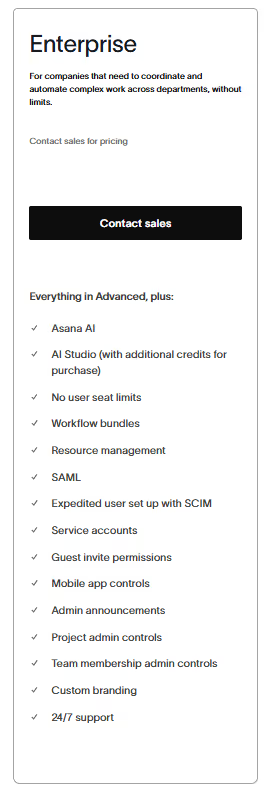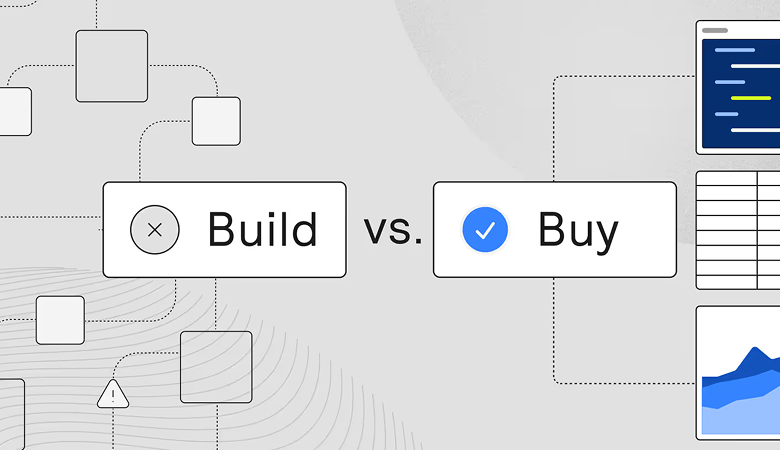Asana helps teams plan work, track progress, and automate routine tasks. The platform includes task views, timeline planning, forms, reporting, and admin controls, plus AI features to summarize work and speed up updates.
Asana is free for up to 10 people and has Team plans starting at $10.99 per user per month when billed annually, or $13.49 when billed monthly. Below, we explain how Asana structures its pricing and where usage-based elements come in.
Note: For the most up-to-date pricing, check Asana’s pricing page. Plan details may change over time. For a primer on models that sit behind tools like Asana, see our guide to subscription pricing.
What are Asana’s pricing models?
.avif)
Asana pricing tiers have different features according to team sizes, functions needed, and administrative control. We’ll take a closer look at how each plan works, including Asana business pricing, Asana enterprise pricing, and usage-based details like automation and AI limits. Let’s zoom in on each plan.
Asana Personal plan (Free)

Free Asana Personal plan includes up to 10 teammates, unlimited tasks and projects, basic views, 100MB file uploads, and over 100 app integrations.
The Asana Personal Plan allows people to manage tasks and projects with no financial commitment. Asana monthly costs would be $0 and include the essentials to get work done.
Key features include:
- Unlimited tasks, projects, and messages
- List, board, and calendar views
- 100MB per file upload limit
- 100+ third-party integrations
- Up to 10 team members
- Basic search and project templates
Starter plan (Asana premium pricing)

Asana Starter plan at $10.99/month adds timeline views, workflow builder, custom fields, forms, advanced search, and automations with no user cap.
Starter introduces core planning and automation tools for growing teams. It lifts the 10-user cap and brings in key features that help track timelines and manage workloads.
Key features include:
- Timeline (Gantt) view for visual planning
- Custom fields and project templates
- Forms for work intake
- Basic dashboards with visual reporting
- Workflow builder with unlimited automations
- Asana AI with ~150 actions per month
- Admin console with privacy and sharing settings
Note: Explore a pricing structure example to see how free and paid tiers typically relate.
Advanced plan (Asana business pricing)

Advanced plan at $24.99/month includes AI Studio access, portfolios, workload tracking, time tracking, approvals, Salesforce integrations, and higher usage limits.
Advanced steps up the feature set with deeper control and visibility across multiple projects and teams. It includes higher usage limits for automation and AI, plus access to AI Studio.
Key features include:
- Portfolios and Goals for team alignment
- Time tracking and workload balancing
- Universal reporting and dashboards
- 25,000 automation rule runs/month
- ~1,500 AI actions/month
- Access to AI Studio with platform credits
- Salesforce, Tableau, and Power BI integrations
- Forms branching, approvals, and custom fields
- Advanced admin permissions and locked fields
Note: If you’re evaluating model changes, here’s how teams run pricing experiments safely.
Enterprise plan (Asana enterprise cost)

Enterprise plan includes unlimited automation, workflow bundles, SAML, SCIM provisioning, admin controls, mobile restrictions, and 24/7 support.
The Enterprise plan unlocks full control, unlimited automation, and high-security features. It’s designed for organizations with strict requirements and large user bases. Asana prices at an enterprise level depend on volume and requirements.
Key features include:
- Unlimited automation and AI usage
- SAML SSO, SCIM provisioning, and service accounts
- Admin controls with audit activity tracking and advanced security settings
- Workflow bundles and company-wide dashboards
- Universal workload and advanced resource tracking
- Data export and custom branding
- 24/7 premium support and onboarding
Note: Read how companies think about enterprise pricing as their needs grow.
Enterprise+ plan

Enterprise+ adds audit logs, HIPAA compliance, data residency, SIEM support, key management, and trusted guest domain controls for regulated industries.
Enterprise+ adds advanced compliance and governance on top of the regular Enterprise features.
Key features include:
- HIPAA compliance and Business Associate Agreements
- Audit log API and SIEM integration
- Enterprise Key Management and data residency options
- Whitelisted guest domains and managed workspaces
- App controls and enhanced admin controls
Asana nonprofit pricing
Asana offers a 50% discount on Starter and Advanced plans for eligible nonprofits. The discount primarily applies to annual subscriptions, and nonprofits must apply through Asana’s nonprofit pricing program.
Note: If a nonprofit is using the free tier but needs more project coordination, this discount can make paid features accessible without inflating Asana costs.
Remember: Pricing, plans, and features are subject to change. For the most up-to-date information, always refer to Asana’s pricing page.
A closer look at Asana's usage-based pricing
Asana pricing focuses on per-user plans, but some features follow a usage-based model, especially AI. These don’t show up in the standard pricing table but can affect how much users end up paying as teams scale. Let’s look at each element.
AI limits by plan
Asana AI includes a range of AI features like task summaries, smart replies, and automated project insights. Asana caps usage based on plan:
- Starter: ~150 AI actions/month
- Advanced: ~1,500 AI actions/month
- Enterprise: Unlimited
AI Studio credits
AI Studio, available on Starter, Advanced, Enterprise, and Enterprise+ plans, introduces a true usage-based pricing layer. It runs on a credit system:
- The system consumes credits based on complexity and volume of AI workflows.
- Plans include a monthly credit allowance.
- Teams can purchase additional credits when needed.
Asana does not publish exact per-credit costs. Admins can track usage within the admin console. Teams using advanced AI workflows (like custom rule builders) should factor these credits into total Asana costs.
Why do companies like Asana adopt usage-based billing?
Usage-based elements help align price with activity. AI actions and rule runs vary by team and by week, so allowances and credits map pricing to real usage.
They also support clear upgrade paths. When teams consistently use more automation or AI, moving to a higher tier or adding credits is simple. This approach keeps the core subscription predictable while giving product teams room to expand AI and automation over time.
Why is usage-based billing becoming the default?
Many teams rely on automation and AI for day-to-day work. Usage-based elements let pricing scale with that activity, while a base subscription keeps access predictable. The mix supports flexible adoption without redesigning plans for every new workflow. Here’s why.
Align price with product value
Metering ties spend to activity. As teams use more automation or AI, their costs increase in proportion to the value they get. This helps finance model ROI and gives product teams clear signals about which features customers rely on most.
Support variable workloads (AI and automation)
Workloads spike during launches, audits, or seasonal campaigns. Allowances and credits handle short bursts without changing the plan itself. Teams keep a stable base and only add more capacity when they actually need it.
Offer clear upgrade paths
Tiers define base entitlements; usage adds flexibility. When automation or AI usage becomes steady, moving up a tier or adding credits is straightforward. Procurement gains predictable SKUs while end users keep familiar workflows.
Reduce engineering lift during pricing changes
Decoupled pricing logic and accurate metering simplify updates. Product and finance can adjust allowances, credit packs, or thresholds without rewriting core functionality. That shortens lead time for packaging changes and lowers operational risk.
Further resources: See the 2025 State of AI Agent Pricing for current patterns in agent and usage pricing. Make sure to also download our Pricing AI Agents eBook and review the agent pricing how-to.
FAQs
What category of software is Asana?
Asana is project management software, sold as a SaaS tool for companies. Teams have used Asana to set up content management systems (CMS), campaign management for marketing, inventory monitoring, and tracking various workflows.
How much does Asana cost per month?
Pricing for Asana starts at $0 for the Personal plan, with paid plans ranging from $10.99 to $30.49 per user/month depending on features and billing frequency. Enterprise pricing is custom, based on usage and team size. Monthly billing is available, but annual plans offer lower rates.
Can you use Asana without a subscription?
Yes, Asana offers a free Personal plan for up to 10 users with access to core task management features. It’s a solid starting point for individuals or small teams. Upgrading unlocks planning tools, timelines, and advanced collaboration.
Learn how Orb supports usage-based billing
Asana offers per-seat pricing with advanced features like automation, tier-based upgrades, and usage-driven AI limits. But behind models like these lies a challenge: Building flexible, accurate billing that evolves as your product and customer base do.
Orb helps SaaS and GenAI companies manage this complexity, turning usage data into a flexible pricing engine that adapts, scales, and drives growth.
Whether you’re managing tiered upgrades, tracking consumption-based actions, or offering AI-powered features with usage caps, Orb gives you the infrastructure to design and manage pricing logic without engineering bottlenecks. Here’s how Orb helps:
- Build adaptive billing workflows: Orb lets you define pricing models that map to product value, whether that’s per seat, per action, or tier-based with thresholds. With the Orb SQL Editor and a visual editor, you can evolve your pricing without rewriting code.
- Monitor usage and create accurate invoices: Orb ingests and tracks all raw event data, enabling you to create pricing models that depend on usage limits or credits. End-customers see transparent, itemized invoices, reducing billing friction.
- Launch new pricing strategies with confidence: Instead of guessing how a change might impact revenue, use Orb Simulations to test pricing changes against real usage data. Run parallel models, forecast outcomes, and refine before going live.
- Enable rapid iteration without disruption: Product teams can launch and update pricing directly, using historical usage data and visual tools with no heavy engineering required. Experiment with billing logic, incentives, and deploy changes across segments.
- Keep operations and finance in sync: Orb integrates with your financial systems, making sure that billing is always accurate. Finance teams get a full audit trail, and every usage event flows into Orb RevGraph, a unified system for pricing, usage, and product data that provides clean reporting.
Orb helps you launch pricing models without complex engineering. Check out Orb’s flexible pricing tiers and see how it can support your product and revenue goals.

.avif)

